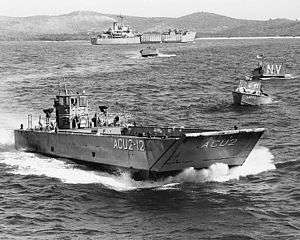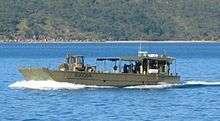LCM-8
 LCM-8 in March 1972 | |
| Class overview | |
|---|---|
| Name: | LCM-8 |
| In service: | 1959 to present |
| General characteristics | |
| Type: | Mechanized landing craft |
| Displacement: |
|
| Length: | 73 ft 7⁄12 in (22.265 m) |
| Beam: | 21 ft 0 in (6.4 m) |
| Draft: |
|
| Propulsion: | (original) 4, 2-twin-pak GMC 6-71 or Gray Marine 6-71 diesel paired to 2 hydrostatic transmissions Detroit 12V-71 diesel engines, twin screws |
| Speed: |
|
| Capacity: | 53.5 long tons (54.4 t) of cargo |
| Complement: | 4–6 |
| Armament: | 2 × 12.7 mm machine guns |
The LCM-8 ("Mike Boat") is a river boat and mechanized landing craft used by the United States Navy and Army during the Vietnam War and subsequent operations. They are currently used by governments and private organizations throughout the world. The acronym stands for "Landing Craft Mechanized, Mark 8". (The "Mike Boat" term refers to the military phonetic alphabet, LCM being "Lima Charlie Mike".)
The vessel weighs 135,000 pounds (61,200 kg) and has a crew of four: a Boatswain's Mate petty officer, an Engineman petty officer, a non-rated fireman, and a seaman. US Army specifications call for a crew of six: two coxswains, two seamen and two enginemen. The LCM-8s are constructed from welded steel and powered by two 12V71 diesel engines, twin propellers, and rudders. The ship can carry 60 short tons of cargo. It was designed by Marinett Marine Corp Dimensions. It has a range of 190 miles at 9kts with a full load.
Modifications
A modified version, the Zippo boat, carries flamethrowers.[1][2] Another modified version, the LCM-8 Mod 2, was used to fulfill command, personnel, salvage, and firefighting functions. There is also another version with an aluminum hull. This version is mostly carried by pre-positioned ships.
A third modification was as a transport for PBRs (patrol boat, river) from repair stations at Da Nang (YR-71) and Tan My (PBR Mobile Base 1) to outlying points at Cua Viet, and the Cua Dai rivers. PBR main propulsion jet pumps were easily damaged by ocean salt water which necessitated the boats being carried by another craft to their duty stations. These transport LCMs were classed as mini-docks and each had a boat ramp in the well deck. The voids (built-in float chambers under the well deck) would be systematically flooded, allowing the front end of the craft to sink, so a PBR could be floated in or out of the well deck. The pumping mechanism would then be reversed to clear the water out of the voids, restoring the craft to normal floating position.
A fourth modification was the Army Version for Vietnam Rivers Logistic with a live aboard cabin and crewed by 6 men consisting of Coxswain, Assist. Coxswain, Engineer and assistance and two Deck Hands. All crew could handle the two 50 Caliber Machine gun turrets and other small arms and were frequently engaged by the Vietcong on the rivers and canals of the Mekong Delta. One unit, an Army Reserve Unit out of St. Petersburg, FL was called to active duty and received a Unit Commendation of merit for delivering record tonnage in their 12-month tour. Army 231st on Mission Vietnam
I feel impelled to edit this. I was with the 1099th River Rats from late 1969 to late 1970. My experience shows that there were two diesel engines for each screw in the mike-8 boat not one. Although they state above there are two screws it seems like they are also saying there were only two engines total.
U.S. usage
They were used by the United States Navy and Army during the Vietnam War. During the Vietnam War, there were two new aluminum LCM-8s on Johnston Island, which carried trucks and cargo between islands, and one being used as a rescue boat. They had the newer fluid shift transmissions, and 2-671's paired up to two props.
In I Corps (the northernmost military district in Vietnam) boats based at Da Nang, Tan My and Cửa Việt had three man crews of various rates and ranks. On U.S. Navy boats, the senior rate was usually a third class petty officer or above, and the two crewmen could be E-2, E-3 or E-4 ranks (i.e. seaman apprentice, seaman, or petty officer third class). One of the two crewmen was almost always an Engineman, and could be an ENFA, ENFN, or an EN3C in rank. The LCM-8s there all had two sets of the twin 6-71 Detroits paired up to a hydro transmission. Two air compressors, port and starboard of the engine sets, provided air pressure to operate the air cylinders that raised and lowered the bow ramp. The air cylinders were below deck in the eighth void from the bow and stretched cables attached to the ramp to raise it. Lowering the ramp was accomplished by releasing the air and allowing gravity to bring the ramp down.
They also saw use during Operation Just Cause in Panama as well as Operation Desert Shield and Operation Desert Storm. Three Army LCM-8s served in the 1992–1993 US mission to Somalia (fictionalized in Christian Bauman's 2002 novel The Ice Beneath You, which is set in part on a US Army LCM-8 near Kismaayo, Somalia), and a platoon of LCM-8s from the 1098th Trans Co. deployed to Port-au-Prince for the Haitian invasion (1994). The United States Army Reserve's 464th Transportation Company assisted the United States Coast Guard in patrolling the Potomac River after the terrorist attacks on September 11, 2001.
Some are currently deployed aboard Maritime Prepositioning ships to facilitate their mission of being able to unload all their cargo while still offshore with no outside assistance.
Replacement
The U.S. Army plans to replace the LCM-8 with the Maneuver Support Vessel (Light) (MSV(L)). Two dozen boats are planned that will be larger and faster, with a longer range and twice the capacity over Mike Boats. The MSV(L) will be roughly 100 feet (30 m) long, with a draft of less than four feet, a speed of 18 knots and the capacity to carry either an M1 Abrams tank, two Strykers with add-on armor, or four Joint Light Tactical Vehicles. It also may be used in defended waters, being fitted with a subsurface surveillance device, protection from small arms fire, two Common Remotely Operated Weapon Stations, and mitigated detection through reduction of thermal and acoustic signature. Testing of the new vessel is to take place until 2019.[3]
Australian service

The LCM-8 was constructed in Australia for the Australian Army from 1965 to 1967 and again in 1972 using a heavily modified design, crewed (four) and administered by the Royal Australian Corps of Transport and one engineer from the Royal Australian Electrical and Mechanical Engineers (RAEME). The modification of the vessels included an extended enclosed wheelhouse with full galley facilities, chart table and storage space to aid in extended operations beyond the original design parameters. A water purification system allows the vessels to be somewhat independent for longer periods of time. A fully functioning toilet (head) and shower are also installed as part of the wheelhouse extensions; external provision for bedding is also included for the full crew complement.
The extension of the wheelhouse increased rigidity of the craft leading to excessive vibration and cavitation with the original three-blade propeller. Further development included a more balanced and expensive five-blade propeller, negating the vibration and cavitation of the original. The prop change found a few negative effects in the beaching performance of the vessel but over time tactics have been changed to suit the new system.
The vessels are also installed with a full suite of electronics allowing the craft to navigate in all weather, day or night in military operations anywhere in the world with little to no special training requirements for an indefinite period.
During the mid-1990s, the Army LCM-8 received a life of type extension with a re-engine program. The original twin-pac 6-71 two-stroke Detroit Diesel engines and Allison mechanical transmissions were replaced with 8v-92 Silver Series Detroit Diesel engines and Allison Hydraulic Transmissions thus extending the life of the craft for another 20 years.
Two craft were utilized during the invasion of Iraq in 2003, patrolling the shallow waters of the Khawr Abd Allah estuary using HMAS Kanimbla as their base of operations. They were extensively used in East Timor for logistic operations in direct support of multinational peace keepers. Other deployments include peacekeeping and peace monitoring operations in Bougainville and the Solomon Islands.
The LCM-8 fleet of fifteen was to be replaced by six Australian designed type LCM2000 waterjet propelled craft, however these craft were scrapped, after not meeting the required in-service specifications and being deemed not fit for use for the intended Kanimbla-class.[4][5][6] The Army will now continue to operate the LCM-8 until 2027.[7][6]
Operators
 Australia - Australian Army
Australia - Australian Army Cambodia - Khmer National Navy
Cambodia - Khmer National Navy France - French Navy
France - French Navy.svg.png) Kingdom of Laos - Royal Lao Navy
Kingdom of Laos - Royal Lao Navy South Vietnam - Republic of Vietnam Navy
South Vietnam - Republic of Vietnam Navy Thailand - Royal Thai Navy
Thailand - Royal Thai Navy Tonga - Tongan Maritime Force
Tonga - Tongan Maritime Force Turkey - Turkish Naval Forces
Turkey - Turkish Naval Forces United States - U.S. Navy; U.S. Army; National Park Service (Channel Islands National Park, Isle Royale National Park)
United States - U.S. Navy; U.S. Army; National Park Service (Channel Islands National Park, Isle Royale National Park) India - Indian Navy
India - Indian Navy
Notes
- ↑ "Tango - Zippo Conversion". Warboats.org. Retrieved 26 August 2015.
The first Zippo boats were ATCs carrying an M132A1 flame-throwing armored personnel carrier
- ↑ "Letters". Smithsonian Magazine. February 1999.
Another type of boat carried a flamethrower that could shoot a stream of burning liquid several hundred yards. These boats ... were called "Zippo" boats
- ↑ US Army To Choose New Landing Craft Next Year - Defensenews.com, 27 August 2015
- ↑ Williams, Adam (March 2006). "Design and Construction of the Army Watercraft" (PDF). Navy Engineering Bulletin. Royal Australian Navy (10): 56–58. Retrieved 26 August 2015.
- ↑ Toune, Rachel (29 July 2010). "Million dollar craft lay idle". Townsville Bulletin. Archived from the original on 30 December 2012.
- 1 2 Cole, Captain G.S. (2014). "Will JP2048 provide Army with an amphibious capability for independent coastal and riverine operations?" (PDF). Australian Army Transport Journal (46): 83–87. Retrieved 26 November 2016.
- ↑ Morley, Sgt Dave (12 February 2015). "Specialists rest easy" (PDF). Army: The Soldiers' Newspaper (1344 ed.). Canberra, Australia: Department of Defence. ISSN 0729-5685. Retrieved 26 November 2016.
External links
| Wikimedia Commons has media related to LCM-8. |
- US Navy
- US Navy
- US Army LCM-8 specification
- LCMs in Panama
- LCMs in Desert Shield/Desert Storm
- US Army Watercraft Operations Field Manual
- 464th TC Deployment
- Army Reserves 231st Med Boat Unit Vietnam 1968-69